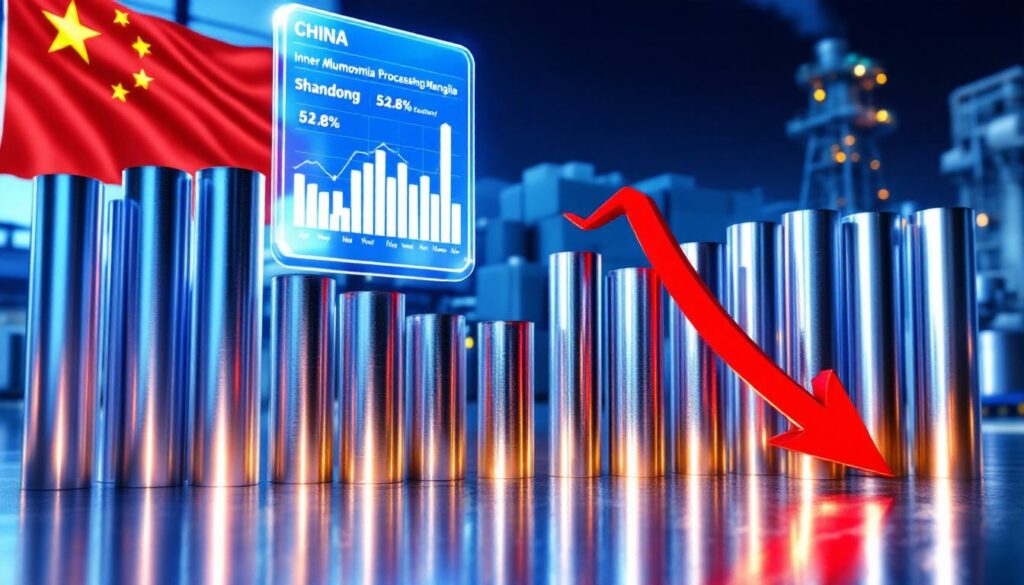What Caused the Plunge in Aluminum Rod Processing Fees in June 2025?
The aluminum rod market experienced significant downward pressure in June 2025, culminating in a dramatic collapse of processing fees across all major production regions. This decline came amid complex supply-demand dynamics that have reshaped the industry landscape. The commodity prices impact has been particularly evident in the aluminum sector.
Market Overview and Production Statistics
Total nationwide aluminum rod production reached 390,000 metric tons in June 2025, representing a substantial decrease of 27,000 metric tons compared to May figures. This production decline occurred as operating rates at aluminum rod plants fell to 60% in June, marking a 2% month-on-month decrease while still remaining 5% higher than the same period last year.
Despite the production slowdown, in-plant inventory showed early signs of accumulation throughout June, with finished products beginning to stack up across manufacturing facilities. This inventory buildup occurred despite notably weak purchasing activity, signaling a fundamental imbalance in the market.
Regional Operating Rate Analysis
When examining the operating landscape across China's aluminum production hubs, significant regional variations emerged:
- Shandong province maintained the highest production intensity with an 82.7% operating rate, experiencing only a slight month-on-month decline
- Inner Mongolia followed with a 75.2% operating rate, also showing a minor month-on-month decrease
- Guangxi, Guizhou, Ningxia, and Qinghai all experienced more pronounced downward operating rate trends
The situation intensified in mid-to-late June when multiple aluminum rod plants announced production cut strategies and maintenance schedules in response to growing inventory pressures. Industry analysts anticipate this supply-side pullback will continue through July 2025 as manufacturers adjust to prevailing market conditions.
"The sustained high operating rates at aluminum rod plants throughout early June contributed significantly to inventory accumulation, creating a supply-demand imbalance that ultimately pressured processing fees downward," noted Shanghai Metal Market's analysis report.
How Did Processing Fees Change Across Different Regions?
The decline in processing fees was not uniform across China's aluminum production landscape, with some regions experiencing significantly steeper drops than others. This variance reveals important insights about regional market dynamics and competitive pressures.
Processing Fee Decline by Production Hub
Production centers witnessed substantial processing fee erosion in June 2025:
- Shandong: 1A60 ex-factory processing fees averaged 310 yuan/mt, representing a substantial decline of 221 yuan/mt month-on-month
- Henan: Ex-factory processing fees averaged 355 yuan/mt, falling by 160 yuan/mt month-on-month
- Inner Mongolia: Ex-factory processing fees averaged just 212 yuan/mt, plummeting by 237.5 yuan/mt month-on-month
Inner Mongolia experienced the most severe decline among production hubs, with processing fees dropping by over 52%, while Henan showed the most resilience with a 31% reduction. This variance largely reflects regional differences in inventory accumulation rates and downstream demand conditions.
Trading Hub Processing Fee Comparison
Trading centers also experienced significant processing fee compression:
- Hebei: Delivered processing fees averaged 302 yuan/mt, down 281 yuan/mt month-on-month
- Jiangsu: Delivered processing fees averaged 382 yuan/mt, falling sharply by 301 yuan/mt month-on-month
- Guangdong: Delivered processing fees averaged 302.5 yuan/mt, decreasing by 281 yuan/mt month-on-month
Notably, Jiangsu maintained the highest absolute processing fee level despite experiencing the largest numerical decline, suggesting stronger underlying demand fundamentals in this economically vibrant region. Industry forecasts indicate processing fees will likely face continued downward pressure in July 2025 as market participants adjust to the new equilibrium.
What Factors Are Driving the Current Market Conditions?
A complex interplay of supply and demand factors contributed to the processing fee collapse, with inventory buildup playing a central role in market dynamics.
Supply-Side Dynamics
The supply situation deteriorated significantly in June 2025:
- In-plant inventory accumulation reached an alarming 9.2 days in June 2025
- This represents a substantial increase of 6.04 days compared to May 2025 levels
- Industry analysts project an inventory operation range of 6-13 days in July 2025
- Multiple manufacturers announced production cuts to address the growing oversupply
- Liquid aluminum alloying tasks maintained some production levels despite weak demand
The rapid inventory buildup indicates that production levels remained too high relative to market absorption capacity, creating a supply overhang that weighed heavily on processing fees. Manufacturers responded by scheduling maintenance and reducing production in an attempt to rebalance the market.
Demand-Side Challenges
Several factors contributed to suppressed demand:
- Persistent high aluminum prices continued to discourage downstream consumption
- A pronounced off-season atmosphere pervaded downstream sectors
- Market purchasing activity weakened significantly compared to previous months
- Trading sentiment remained low throughout the industry supply chain
- Processing fee levels faced difficulty improving in the short term
The combination of seasonal weakness and elevated raw material costs created a particularly challenging environment for aluminum rod manufacturers. Downstream wire and cable producers, facing their own margin pressures, reduced purchases and operated primarily from existing inventories. Furthermore, China's commodity surplus has contributed significantly to the market imbalance.
"The market is experiencing a classic supply-demand imbalance, with inventory accumulation forcing manufacturers to compete aggressively on processing fees to maintain market share during this period of reduced demand," according to industry analysis.
What Is the Outlook for Aluminum Rod Processing Fees?
Market participants are closely monitoring both short-term pressures and medium-term recovery potential as they formulate strategies for the remainder of 2025.
Short-Term Forecast (July-August 2025)
The immediate outlook remains challenging:
- Processing fees likely to continue operating at depressed levels
- Supply surplus pressure may ease slightly due to announced production cuts
- Inventory accumulation trend expected to continue but at a slower pace
- Limited upside potential for processing fees in the immediate future
- Trading activity projected to remain subdued
The July-August period typically represents seasonal weakness for aluminum demand in China, and 2025 appears to be following this pattern. Manufacturers will need to carefully manage production levels to prevent further inventory buildup during this challenging period.
Medium to Long-Term Perspective
Despite current challenges, several positive factors could support a recovery:
- Downstream wire and cable enterprises have substantial backlog orders
- A concentrated delivery phase is expected in the second half of 2025
- Underlying rigid demand should provide fundamental support for industry consumption
- Recovery in processing fees may lag due to the need to work through accumulated inventory
- The timeline for market normalization depends on successful inventory reduction and demand resurgence
The substantial backlog of orders in downstream sectors suggests that demand could rebound significantly once seasonal factors improve and inventory levels normalize. However, the accumulated supply overhang means that processing fee recovery may be gradual rather than immediate.
Industry analysts anticipate that September-October 2025 could mark the beginning of a recovery cycle, assuming inventory levels can be successfully reduced through the production cuts already announced by major manufacturers. In addition, understanding commodity trading insights can help stakeholders navigate this challenging market environment.
FAQ: Aluminum Rod Market Conditions
What is causing the decline in aluminum rod processing fees?
The decline stems from a combination of oversupply conditions, weak downstream demand, sustained high aluminum prices suppressing consumption, and seasonal factors creating a relative supply surplus in the market. The rapid inventory accumulation (reaching 9.2 days in June) created competitive pressure among manufacturers, forcing processing fee reductions to maintain sales volumes.
How are manufacturers responding to current market conditions?
Many aluminum rod plants have announced production cuts and equipment maintenance schedules in response to increasing inventory pressure and weak demand. Operating rates are expected to decline across various provinces in July, with some facilities reducing production by 10-20% until market conditions improve. This coordinated supply-side response aims to rebalance the market and stabilize processing fees.
Will processing fees recover in the near future?
Short-term recovery appears limited due to persistent oversupply and weak demand. However, medium-term prospects show potential improvement as downstream wire and cable enterprises have substantial backlog orders with concentrated delivery expected in the second half of 2025. Recovery timing will depend largely on how quickly inventory levels can be normalized through production discipline and seasonal demand improvements.
How do processing fees vary across different regions?
Major production hubs like Shandong, Henan, and Inner Mongolia, as well as trading centers including Hebei, Jiangsu, and Guangdong, all experienced significant processing fee declines in June 2025. Regional variations reflect local supply-demand dynamics, transportation factors, and production cost differences. Henan demonstrated the greatest resilience (-31.1%), while Inner Mongolia suffered the steepest decline (-52.8%).
Comparative Analysis: Processing Fee Trends Across Regions
The following table provides a comprehensive overview of processing fee changes across China's major aluminum rod production and trading regions:
| Region | June 2025 Processing Fee (yuan/mt) | Monthly Change (yuan/mt) | Percentage Decline |
|---|---|---|---|
| Shandong | 310 | ↓221 | -41.6% |
| Henan | 355 | ↓160 | -31.1% |
| Inner Mongolia | 212 | ↓237.5 | -52.8% |
| Hebei | 302 | ↓281 | -48.2% |
| Jiangsu | 382 | ↓301 | -44.1% |
| Guangdong | 302.5 | ↓281 | -48.2% |
Market Insight: Inner Mongolia experienced the most severe processing fee decline at 52.8%, while Henan showed the most resilience with a 31.1% reduction. These regional variations highlight the uneven impact of market pressures across different production centers.
The data reveals that Jiangsu maintained the highest absolute processing fee level (382 yuan/mt) despite experiencing one of the largest nominal declines. This suggests stronger underlying demand fundamentals in this economically developed region compared to other areas of China.
Conversely, Inner Mongolia's processing fees fell to just 212 yuan/mt—the lowest among all regions—despite having the second-highest operating rate at 75.2%. This incongruity indicates that Inner Mongolia's production levels remained significantly misaligned with regional demand, forcing manufacturers to accept steeper processing fee reductions to move inventory.
The processing fees of aluminum rods will likely continue facing pressure until the market achieves a more sustainable balance between production volumes and end-user demand. Manufacturers and traders are advised to closely monitor inventory levels and downstream order patterns for early signals of market stabilization. Additionally, understanding the mineral beneficiation benefits could provide valuable context for long-term industry trends.
Disclaimer: This market analysis represents current conditions and projections based on available data. Actual market developments may vary based on unforeseen economic factors, policy changes, or shifts in downstream demand patterns.
Looking for the Next Big Mineral Discovery?
Don't miss potential market-moving announcements – Discovery Alert's proprietary Discovery IQ model instantly notifies investors of significant ASX mineral discoveries, transforming complex data into actionable insights. Visit our dedicated discoveries page to understand why major mineral finds can generate substantial returns and begin your 30-day free trial today.




